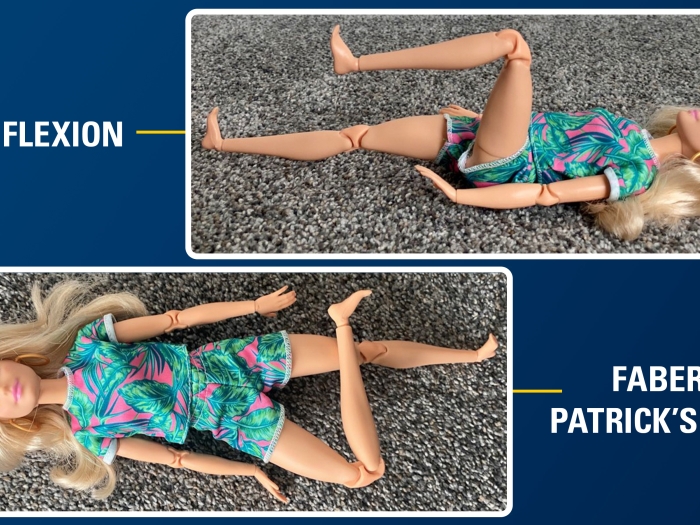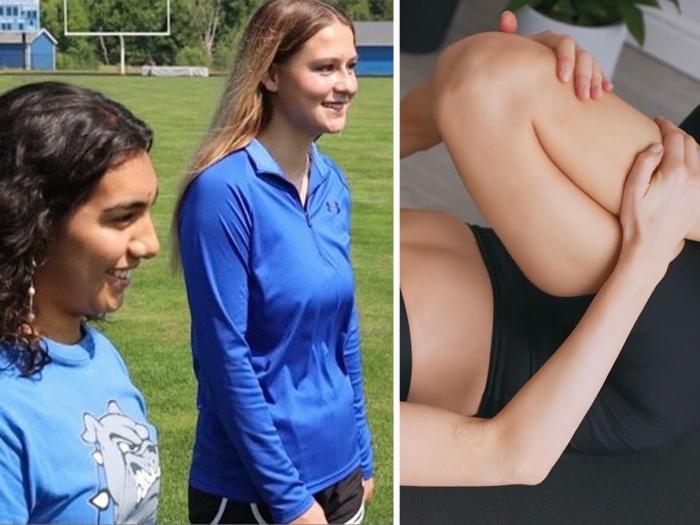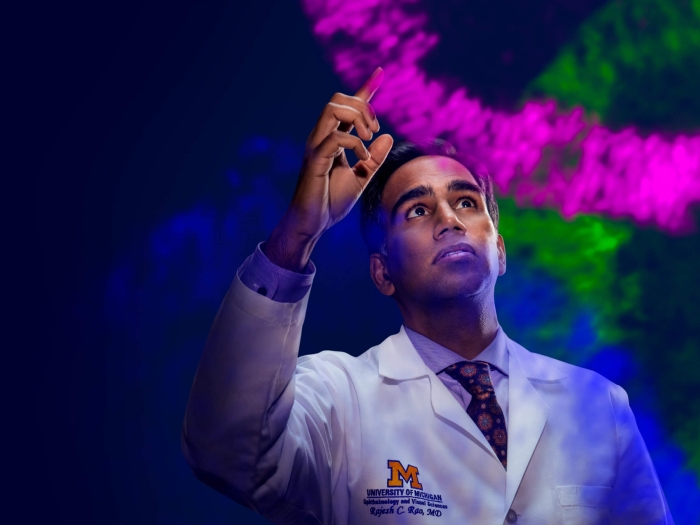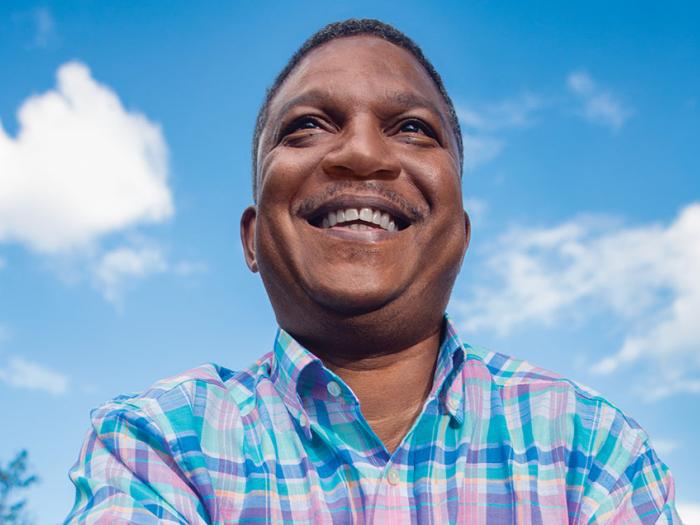
Thousands of tiny yellow, green and red lines swirl around Travar Pettway. As he gently tilts his head, the shapes glide and adjust, perfectly rendered in 3-D. He’s lost in a sea of color and movement.
20 feet away in an adjoining room, his rehab engineer and longtime friend, Donn Hilker, smiles as he watches his patient help shape the future of rehabilitation care.
“This isn’t the kid I met all those years ago lying in a hospital bed,” Donn recalls. “Travar has become something remarkable. Maybe even someone he never saw himself becoming.”
On January 14, 1995, Travar — then an 18-year-old high school senior — was struck in the neck by a bullet while driving with his cousin near his home in Detroit. The bullet missed his spine, but the subsequent shockwave caused severe damage.
Explains Travar, “I have an injury to the C1-C2 vertebrae of my spinal cord. It’s an incomplete break, meaning that my neck isn’t broken, just damaged.”
He was quickly transported to a nearby hospital, where he received emergency treatment. Not long after, his family chose to transfer him to University of Michigan Health, Michigan Medicine, where he began to slowly realize his situation was possibly permanent.
Donn remembers that early transition.
“Travar went from a young and active guy to being completely dependent upon caregivers, a ventilator and feeding tube. He had no mobility. And besides the new physical setting of the hospital, Travar was surrounded by and dependent upon individuals very different from the where he came from. Different perspectives, different experiences. He realized he would have to trust these strangers.”
Travar recalls having a more optimistic first impression.
“In the first three days, I was in and out of a coma. When I came around and I kind of got stable, I thought I’d be in the hospital for another week or so. I’ll get out and do a few pushups and I’d be back in regular life.”
But a one-on-one conversation with Dr. Lance Goetz, his U-M physician at that time who also has a spinal cord injury and uses a wheelchair for mobility, allowed Travar to see just how serious his situation was.
One day he casually asked Dr. Goetz, “‘So what’s the long-term plan here? Am I going to be in this chair for a while?’ Mind you, this doctor is paralyzed from the waist down. He just said, ‘Travar, I’ll never give up hope.’”
That sobering honesty finally showed Travar the path that lay ahead.
He remembers, “I don’t think anybody else could have had that conversation with me. If someone else would have told me, ‘Hey, you’re going to be in that wheelchair forever,’ I would have said, ‘No. No, I’m going to fight this thing.’ Hearing it through him, it was just a realization that it’s a possibility it’s going to be a while, but it’s not a death sentence. You can still have a life that’s well.”
With a clearer understanding of what his life would now be like, Travar’s journey intersected with Donn.
As the Clinical Director for the University of Michigan Health Rehabilitation Engineering Program, Donn leads a team who meets with patients like Travar to use engineering and technology to increase the functional capabilities and quality of life of individuals with disability.
“Our first step is to listen and find out what a patient hopes to accomplish and how they want to proceed with their life now. And Travar, well, he had a lot of plans,” Donn explains.
Travar’s plans led first to a local college before his focus turned to enrolling at a campus he was very familiar visiting.
“I started talking with my mom about making plans to move to Ann Arbor. I wanted to go to school at U-M. I applied. They denied me. I applied again, and they denied me again,” Travar recalls with a chuckle.
But his third application was accepted, and Travar made a move to Ann Arbor to begin his current journey: earning his bachelor’s degree. Something that would never have been possible without his almost two-decades-long relationship with Donn. Travar is currently working on a law degree so he can help others with disability and give back to Michigan and his hometown Detroit.
“I was always pushing the envelope, and I think in some of those ways Donn may have seen that as a challenge. When we have discussions, I think we can see each other’s wheels turning. I’ll say, ‘I’d like to do this.’ He’s like, ‘Well, you know we’ve got this and we’ve got this. I’m hearing they’re making this.’ It just became kind of a camaraderie of intellectuals,” says Travar.
Over time, Donn began to ask Travar to speak to other paralyzed patients. Ones who, like Travar in his earliest days of care, didn’t know what to expect.
“It can be difficult to speak of hope in our professional role,” says Donn. “Travar can share with other patients his physical and personal experiences. He’s become somewhat of a ‘SCI Minister’ as he steps into his role of mentoring others with quadriplegia.”
And that brings us to today, and this 10-foot cube full of projections and 3-D renderings inside the Duderstadt Center on the campus of U-M College of Engineering.
Donn has invited Travar to come experience the MiDEN (Michigan Immersive Digital Experience Nexus), which uses stereoscopic projections to create a fully immersive experience that tracks where the user is within a space and adapts the simulation to what the person would expect to see. MiDen is a state-of-the-art “technical playground” run by the day’s host Ted Hall.
Even beyond his role as mentor, Travar relishes the opportunity to be Donn’s “test pilot,” especially when it comes to anything tech.
Donn explains, “We don’t have any formal plans for the MiDEN, yet. But this is why a place like Michigan Medicine is so powerful. This technology is within walking distance from my office. From where patients are being treated. I get to bring someone like Travar here and just dream.”
And Travar is dreaming. He sees patients like him using virtual reality tools like the MiDEN to compose music, perform to thousands or even fly airplanes.
“VR will change the lives of people like me,” he boldly states.
Travar then turns to Donn and with a wry smile says, “Hey, you think you can swipe whatever computer is running this thing and stash it in my van?”
They both laugh.

Discover the power of a Michigan Answer through inspiring stories. Find hope and inspiration for your own journey by reading more.





